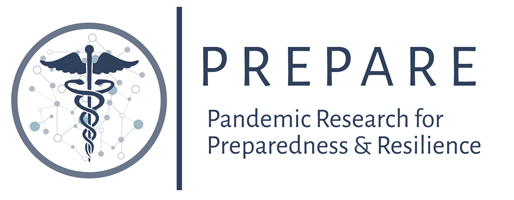Members
PREPARE is a global network of passionate members who drive forward the scientific and public health advances necessary to ready us for the next pandemic. Join us to grow your network, find and share upcoming events, and participate in our workshops!
Enter keywords to search the member names or info cards:
Constance Jeffery

- Associate Professor of Biological Sciences
The genome projects yielded the sequences of tens of thousands of proteins. Elucidating the roles these proteins play in health and disease, and also how they can be used and/or modified for the development of novel therapeutics, biomaterials, biosensors, methods for energy production and methods for environmental remediation, will be aided by a better understanding of how a protein's amino acid sequence determines its structure and how structure determines function. The Jeffery lab's research on protein structure and function combines methods from biophysics (X-ray crystallography), biochemistry, and bioinformatics to address questions such as: how does an enzyme bind to its substrate and convert it to product? how do two similar proteins perform different functions? how do some proteins perform multiple, unrelated ‘moonlighting functions’? how can we find small molecules that disrupt functions in proteins in cancer and tuberculosis and that can serve as drug leads? and how do mutations in proteins associated with autoimmune disease affect the proteins’ structures and functions? In addition to research, Prof. Jeffery teaches upper level undergraduate biochemistry (Bios352/Chem352) and a first-year graduate course in molecular biology and biochemistry (Bios524).
(1) Analysis of protein sequences and structures to elucidate the connections between sequence, structure and function. This information might help in the future in developing better methods to predict a protein's function(s) from its sequence or structure. Two current projects in this area include an analysis of ligand binding sites in protein crystal structures and a study of the sequences and structures of "moonlighting proteins". Many protein functions can be inferred from the known functions of homologous proteins, but determining protein functions is complicated by an increasing number of "moonlighting proteins", proteins that have more than one function where the multiple functions are not a result of splice variants, gene fusions, or multiple isoforms (Jeffery, C. J. Moonlighting Proteins. (1999) Trends in Biochemical Sciences. 24: 8-11). We have created a database of the known moonlighting proteins (The MoonProt Database at moonlightingproteins.org) and are performing an analysis of their sequences and structures. Knowing more about moonlighting proteins could help in predicting which additional proteins might also have a second function, which would be useful in determining the function(s) of the thousands of proteins identified through the genome projects and the functions of the "unknown" proteins whose structures were solved as part of the Protein Structure Initiative. In addition, since the ability of proteins to moonlight can complicate interpretation of the results of proteomics projects, identifying the roles of proteins in disease, and the selection of biomarkers, understanding which proteins moonlight can be important for both basic research and medicine.
(2) The development of novel approaches to increase the expression of transmembrane proteins for biochemical analysis and structure determination. Membrane proteins play key roles in health and disease and are the targets of the majority of pharmaceuticals in use today, but much less is known about their structures and mechanisms of function than for soluble proteins because of the challenges in their expression, purification, and structure determination. The goal of our new approaches is to alleviate the bottleneck in protein expression.
(3) In a previous project, we elucidated the reaction mechanism of a glycolytic enzyme that moonlights as a tumor cell motility factor in breast cancer cells: phosphoglucose isomerase/autocrine motility factor (PGI/AMF). By solving six structures of PGI/AMF with different ligands bound, we developed a model of the multistep catalytic mechanism for this multifunctional enzyme/growth factor.
Education, Training, and Workforce Development, Computational Biology and Bioinformatics
Branden Johnson

- Senior Research Scientist
Dr. Johnson's main focus has been basic and applied research in academia (U. Pittsburgh, Michigan Technological U.), government (New Jersey Dept. of Environmental Protection), and the non-profit sector (Decision Research), but he has also worked as a regulator of drinking water safety (NJDEP). Although the bulk of his research has concerned environmental issues (water, air pollution, radioactive waste, black bears, wetlands, etc.), he has also worked on terrorism, food safety, and cancer clusters, among other topics, and am willing to study other technological, natural and social hazards. His work as a social scientist has involved extensive collaboration with natural scientists and engineers as well as other behavioral and social scientists, and with partners from academia, government, business, nonprofit, and activist organizations, and he is open to new research collaborations. His specialties are in risk perception and risk communication; environmental policy; hazard management; and qualitative and quantitative research methods.
Effective public health communication requires a good understanding of what audiences (and communicators) need to know about the topic, yet measures of "objective knowledge" that cover all potential issues but can be tailored to the specific pandemic of the moment are not available. He is looking for a multi-disciplinary team of natural, social, and public health scientists who would like to seek funding for developing, testing, and making publicly available a suite of valid and reliable measures that could be used in future efforts to identify knowledge gaps, and track efficacy of communication efforts, as well as inform the better design in advance of those communications.
He has conducted three longitudinal surveys to study the dynamics of Ebola, Zika, and COVID-19 views (e.g., risk perceptions; policy support) and behaviors, and their antecedent factors, among mainland U.S. samples, and learned a great deal about how to improve those designs. However, he feels even more could be accomplished with a broader team, and invites interested parties to collaborate on developing, and seeking funding for, an improved approach to encourage more use of this useful but challenging longitudinal approach. At minimum, he hopes to seek to develop a template that could be made available as a public resource for the next generation of researchers, and for international researchers with fewer resources; he also could propose that funding be made available for that purpose as well as underwrite timely data collection at the next pandemic to illustrate its benefits while addressing public health needs. He's open to social scientists from varied disciplines, as the character of this effort would depend upon who is involved.
Social, Behavioral, Economic, and Governance


